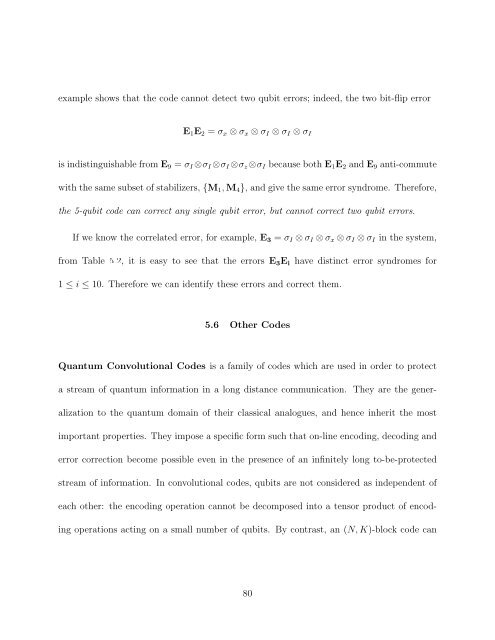t b a b a
t b a b a
t b a b a
Create successful ePaper yourself
Turn your PDF publications into a flip-book with our unique Google optimized e-Paper software.
example shows that the code cannot detect two qubit errors; indeed, the two bit-flip error<br />
E1E2 = σx ⊗ σx ⊗ σI ⊗ σI ⊗ σI<br />
is indistinguishable from E9 = σI ⊗σI ⊗σI ⊗σz ⊗σI because both E1E2 and E9 anti-commute<br />
with the same subset of stabilizers, {M1, M4}, and give the same error syndrome. Therefore,<br />
the 5-qubit code can correct any single qubit error, but cannot correct two qubit errors.<br />
If we know the correlated error, for example, E3 = σI ⊗ σI ⊗ σx ⊗ σI ⊗ σI in the system,<br />
from Table 5.2, it is easy to see that the errors E3Ei have distinct error syndromes for<br />
1 ≤ i ≤ 10. Therefore we can identify these errors and correct them.<br />
5.6 Other Codes<br />
Quantum Convolutional Codes is a family of codes which are used in order to protect<br />
a stream of quantum information in a long distance communication. They are the gener-<br />
alization to the quantum domain of their classical analogues, and hence inherit the most<br />
important properties. They impose a specific form such that on-line encoding, decoding and<br />
error correction become possible even in the presence of an infinitely long to-be-protected<br />
stream of information. In convolutional codes, qubits are not considered as independent of<br />
each other: the encoding operation cannot be decomposed into a tensor product of encod-<br />
ing operations acting on a small number of qubits. By contrast, an (N, K)-block code can<br />
80

















